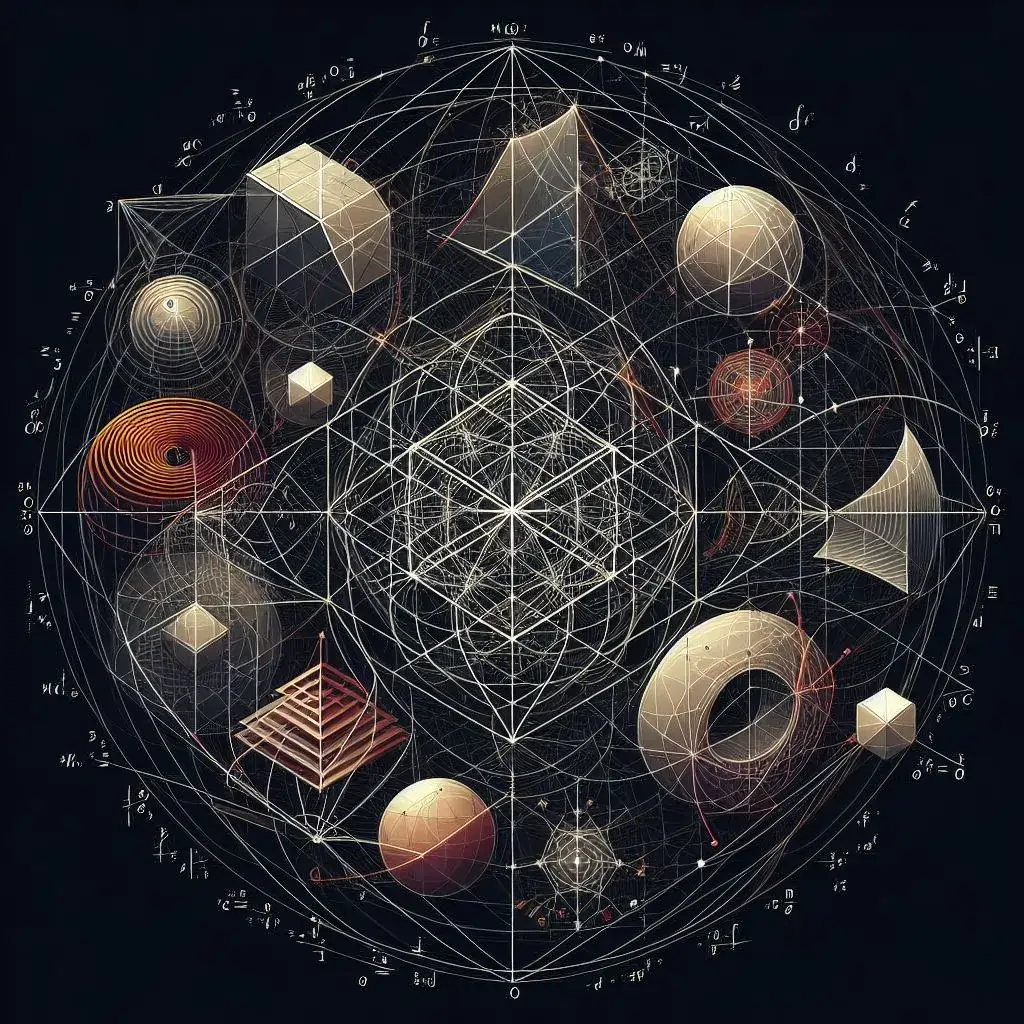Exploring the Intricacies of The Geometry of Vector Spaces: From Basics to Applications

The world of mathematics unfolds as an expansive and intricate tapestry, where each thread contributes to the collective comprehension of abstract concepts and their tangible applications. Within this rich landscape, the study of vector spaces emerges as a fundamental and remarkably versatile branch, occupying a pivotal role across diverse fields—from the intricate realms of physics and engineering to the dynamic landscapes of computer science and economics. This comprehensive exploration embarks on a journey into the geometric dimensions of vector spaces, peeling back the layers to reveal the foundational basics and tracing the intricate applications that span across varied domains. Vector spaces, equipped with the essential operations of addition and scalar multiplication, establish a robust foundation. Properties such as closure under operations form the bedrock of this mathematical framework, providing a scaffold upon which the entire theory of vector spaces is constructed. As we navigate through the fundamentals, the concepts of vector subspaces and spanning sets come into focus, illuminating the structural intricacies and dimensionality of vector spaces. If you need assistance with your Geometry Assignment, understanding the concepts of vector subspaces and spanning sets within vector spaces can provide valuable insights into geometric transformations and relationships.

Beyond the theoretical underpinnings, the exploration extends into the familiar territory of Euclidean spaces, where vectors manifest as n-tuples of real numbers, and the geometric interpretation becomes a visual guide to vector operations, norms, and inner products. The significance of norms, elucidating vector magnitude, and inner products, capturing angles and orthogonality, adds a layer of depth to our geometric understanding. Linear transformations emerge as powerful tools, bridging different vector spaces, and matrices become the visual language of these transformations. Eigenvalues and eigenvectors contribute to the stability and directional aspects, further enriching the geometric tapestry of linear transformations. The journey doesn't conclude within the confines of mathematical abstraction; it extends its tendrils into real-world applications.
In physics and engineering, vector spaces offer a language to describe the intricate dance of particles and the modeling of electromagnetic fields. In computer science, the geometric properties of vector spaces underpin data representation, image processing, and machine learning algorithms. Economics finds vector spaces indispensable in optimization problems and game theory, where the geometric interpretation unravels decision-making processes and equilibrium points. This comprehensive exploration underscores the enduring relevance and cross-disciplinary nature of vector spaces, emphasizing their integral role in shaping our understanding of mathematical concepts and their pragmatic applications in the world around us.
Fundamentals of Vector Spaces
In the foundational exploration of vector spaces, we immerse ourselves in the fundamental concepts that underpin this mathematical domain. A vector space, defined by a set of elements and two fundamental operations – addition and scalar multiplication – serves as the cornerstone of this mathematical structure. The properties governing these operations, such as closure, associativity, and distributivity, lay the groundwork for a deeper understanding of vector spaces. Within this framework, the notion of vector subspaces emerges, revealing subsets that preserve the essential properties of the overarching vector space. Complementary to this concept is the idea of spanning sets, elucidating the reach and dimensionality of vector spaces by showcasing their capacity to generate the entire space through linear combinations. As we navigate these fundamental principles, the abstract nature of vector spaces begins to manifest geometrically, paving the way for a more nuanced exploration of their spatial characteristics. These fundamentals not only serve as the building blocks for more advanced concepts but also provide a crucial bridge to the geometric aspects that define the intricate tapestry of vector spaces.
- Definition and Properties
To embark on our journey into the geometry of vector spaces, we must first establish a solid foundation by understanding the fundamental concepts. A vector space is a mathematical structure equipped with two operations—addition and scalar multiplication—that satisfy specific properties. These properties, such as closure under addition and scalar multiplication, form the bedrock upon which the entire theory of vector spaces is built.
- Vector Subspaces and Spanning Sets
As we navigate deeper into the subject, we encounter the notion of vector subspaces and spanning sets. Vector subspaces are subsets of a vector space that retain the vector space's essential properties, while spanning sets help us understand the reach and dimensionality of vector spaces. These concepts pave the way for a more profound exploration of the geometric characteristics inherent in vector spaces.
Geometry of Euclidean Spaces
In the exploration of the geometry of Euclidean spaces, we immerse ourselves in a realm where vectors take on tangible significance within n-dimensional space. Euclidean vector spaces, defined by n-tuples of real numbers, provide a fertile ground for understanding geometric principles that extend beyond abstract mathematical constructs. Here, vectors become visual entities, representing points in space, and their operations acquire a palpable geometric interpretation. Norms, acting as metrics of vector lengths, unveil the spatial magnitude of vectors, while inner products delineate angles and orthogonality relationships, imparting a sense of directional alignment. The geometry of Euclidean spaces illuminates the intricate dance of vectors in response to linear transformations, where concepts like image and kernel spaces come to life as dynamic representations of evolving geometric structures. This exploration extends to matrices, where their role in encapsulating linear transformations manifests as a bridge connecting algebraic operations with geometric transformations. Eigenvalues and eigenvectors emerge as beacons, guiding us through the stability and directionality inherent in these transformations. The visual language of linear transformations and matrices enriches our understanding of the geometric interplay between vectors and their evolving landscapes. In this dimension of Euclidean spaces, the marriage of abstract mathematical concepts with tangible geometric representations creates a powerful framework, fostering a deeper appreciation for the role these spaces play in the broader tapestry of mathematical understanding and real-world applications.
- Euclidean Vector Spaces
One of the most familiar and widely studied instances of vector spaces is the Euclidean space. In Euclidean spaces, vectors are represented as n-tuples of real numbers, and geometrically, they correspond to points in n-dimensional space. The geometry of Euclidean spaces provides an intuitive visual understanding of vector operations, norms, and inner products.
- Norms and Inner Products
Norms and inner products are crucial elements in understanding the geometry of vector spaces. The norm of a vector measures its size or length, providing a geometric interpretation of magnitude. Inner products, on the other hand, capture the notion of angle and orthogonality between vectors. Exploring these concepts in the context of Euclidean spaces elucidates their geometric significance.
Linear Transformations and Matrices
Linear transformations and matrices constitute a pivotal chapter in the exploration of the geometry of vector spaces. These mathematical tools serve as bridges connecting different vector spaces, unveiling the intricate transformations vectors undergo. Linear transformations, fundamental operations preserving vector space structure, introduce concepts like image and kernel spaces, shedding light on how vectors evolve under these operations. Visualizing linear transformations provides an intuitive grasp of their geometric implications, offering a dynamic perspective on the interplay between vectors and space. Matrices emerge as powerful representations of linear transformations, encapsulating their essence and facilitating computations. Within this framework, eigenvalues and eigenvectors take center stage, revealing the stability and directional properties of linear transformations. Matrices play a pivotal role in a variety of applications, from physics and engineering to computer science and economics, exemplifying their ubiquity in modeling real-world phenomena. Understanding the geometry behind matrices enriches our comprehension of their role, emphasizing their significance not only in theoretical constructs but also in practical problem-solving contexts. As we navigate the realm of linear transformations and matrices, we unravel the geometric intricacies that underpin their influence, fostering a deeper appreciation for their role as indispensable tools in the study and application of vector spaces.
- Linear Transformations
Linear transformations play a pivotal role in connecting different vector spaces. Understanding the geometric implications of linear transformations involves exploring concepts such as image and kernel spaces, isomorphisms, and eigenvalues. The visual representation of linear transformations provides insights into how vectors evolve under these operations.
- Matrices and Eigenvalues
Matrices serve as powerful tools for representing linear transformations and capturing their geometric essence. Eigenvalues and eigenvectors emerge as key concepts, shedding light on the inherent stability and directional properties of linear transformations. Unraveling the geometry behind matrices deepens our comprehension of their role in various applications.
Applications Across Disciplines
Applications of vector spaces reverberate across diverse disciplines, illustrating the profound impact of geometric principles on solving real-world problems. In the realms of physics and engineering, vector spaces offer a powerful language to articulate the dynamics of physical systems, from modeling the trajectory of particles to characterizing the intricacies of electromagnetic fields. In computer science and machine learning, the geometric properties of vector spaces come to the forefront, providing a robust framework for data representation, image processing, and algorithmic tasks like clustering and classification. This interplay between theory and application showcases how vector spaces become foundational in transforming abstract mathematical concepts into practical solutions. Moreover, economics and optimization benefit significantly from the geometric interpretation of vector spaces, enabling a nuanced understanding of decision-making processes and equilibrium points in economic models and game theory. The ubiquity of vector spaces across these disciplines underscores their versatility and indispensability, illustrating how a solid grasp of the geometric intricacies can enhance problem-solving approaches and foster interdisciplinary insights. As we navigate through the varied applications, the significance of vector spaces becomes apparent, transcending theoretical boundaries to become an integral component in shaping the landscape of scientific inquiry and technological advancement.
- Physics and Engineering
Vector spaces find extensive applications in the physical sciences and engineering disciplines. From describing the motion of particles to modeling electromagnetic fields, the geometric principles of vector spaces offer a rich framework for understanding and solving complex problems.
- Computer Science and Machine Learning
In the realm of computer science, vector spaces are instrumental in representing data, images, and features. Machine learning algorithms leverage the geometric properties of vector spaces to perform tasks such as clustering, classification, and dimensionality reduction. Exploring these applications unveils the synergy between theoretical concepts and real-world problems.
- Economics and Optimization
In economics, vector spaces play a crucial role in optimization problems and game theory. The geometric interpretation of optimization objectives and constraints provides valuable insights into decision-making processes and equilibrium points. Understanding these applications highlights the interdisciplinary nature of vector spaces.
Conclusion
In conclusion, the intricate world of vector spaces unfolds as a geometric tapestry with profound implications across diverse domains. From the foundational principles defining vector spaces, including closure under addition and scalar multiplication, to the exploration of Euclidean spaces and their geometric nuances, the journey has been a deep dive into the abstract yet tangible realm of mathematical structures. The geometric interpretation of norms and inner products in Euclidean spaces provides an intuitive understanding of vector magnitude and angular relationships, connecting algebraic operations to spatial intuition. The introduction of linear transformations and matrices further enriches our comprehension, unveiling the geometric metamorphosis that vectors undergo under these operations. As we navigate through applications spanning physics and engineering, computer science and machine learning, as well as economics and optimization, the versatility of vector spaces becomes apparent. They emerge as indispensable tools for modeling real-world phenomena and solving complex problems, emphasizing the pervasive influence of mathematical abstraction on practical scenarios. In this exploration, the synergy between theoretical foundations and interdisciplinary applications underscores the timeless significance of vector spaces, solidifying their role as a cornerstone in the edifice of mathematical knowledge, seamlessly bridging the gap between abstract concepts and their real-world implications.